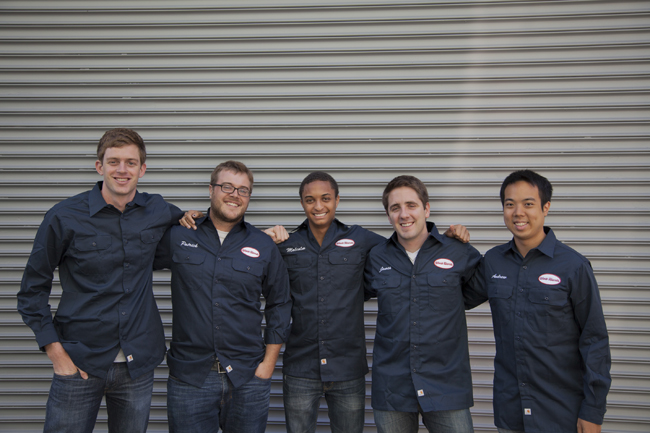Chapter 5:
How We Work
“WorkHands Wants to Become the Blue-Collar LinkedIn,” Lauren Orsini
Chances are, we are all familiar with the LinkedIn website. But less obvious are the unspoken ways this increasingly popular social networking site draws boundaries between the worlds of white-collar and blue-collar work. Where, we might ask, is the site that caters to the networking needs of those who work with their hands? WorkHands seeks to answer that question.

According to the most recent statistics from the Kaiser Family Foundation, blue collar workers make up roughly 60% of the workforce in each U.S. state. However, you’d never know that browsing the Internet.
While there are dozens of job boards that specialize in white collar jobs, if you’re looking for a skilled labor job, your best bet is to check your local Craigslist listings. The staff of WorkHands, is hoping to change that. A LinkedIn-like service for blue collar workers in the U.S., a new social network that launched Tuesday.
Putting The Internet To Work
A software engineer, WorkHands CEO Patrick Cushing is the black sheep of his blue collar family. His dad fixed oil burners for a living, and his brother is a professional welder. He realized first hand that blue collar workers are always online, even if their jobs are not.
“My brother has had Facebook since the beginning,” he said. “I looked at someone like my brother and realized he had all these online tools for his social life and none for his work career."
Perhaps because of the white collar backgrounds of most Silicon Valley types, most job networks are designed with similar job hunters in mind. There are thousands of blue collar professionals connected on LinkedIn, but Cushing argues that network doesn’t cater to them as specifically as WorkHands does.
“Linkedin makes it really hard to demonstrate what you’re great at in the trades,” he said. “If you’re a great welder, one of the best ways to demonstrate that is to show your welds.”
A machinist's profile on WorkHands.
In the same vein, the most prominent part of any WorkHands profile is a photo gallery. In this early adopter’s profile, photos of the student’s metalwork are placed more prominently than his experience or education history. Just like skillful code can be a ready calling card for a tech job, a well-welded piece of metal may be all a trades employer needs to see.
WorkHands profiles also include sections you’d never see on LinkedIn, such as a place for workers to list the types of power tools they own and can use or a list of the workers’ licenses and certifications, used for operating heavy machinery or driving utility vehicles. But through testers, the WorkHands crew has met with the most enthusiasm with the photo gallery feature.
“So many of the workers we talk to, we ask about their work and they pull out their phone and have pages and pages of photos of it,” said Cushing. “They’re inherently proud of the work they do with their hands.”
Keeping Social Going
For this reason, the WorkHands crew believes that it can keep workers using the network even after they’ve already found a job. They can upload photos and approve of connections’ handiwork by clicking the “solid” button, a straight-talking version of Facebook’s “like.”
Other features are on the way, too. This quarter, Cushing hopes to launch private networks for technical schools, employers, and other organizations, a mobile app, and a job board. Right now WorkHands is free for workers and employers alike, but eventually the network will make money by charging companies for their job listings.
Already, WorkHands has helped a handful of students at Laney College in Oakland, CA find jobs at a local ironworking company. The network has worked well for students, who are already constantly online, and for companies, which before have never had a network to find welders, woodworkers, and other skilled laborers all in one place.
The blue collar Internet already existed, said Cushing. They just needed the right tools.
“The assumption that this workforce isn’t already online is something we’re really trying to challenge,” said Cushing.
Discussion and Writing Questions
After reading “WorkHands Wants to Become the Blue-Collar LinkedIn,” consider the questions below.
Question 5.1
1. How do you respond to the phrase blue-collar LinkedIn? What specific assumptions or associations does it challenge? Does this phrase seem to be a contradiction in terms?
Question 5.2
2. The article shows an image of a group of blue-collar workers linked arm-in-arm. What do you think this image illustrates? Do you find it to be an effective strategy for introducing or previewing the discussion of WorkHands to come? Why or why not?
Question 5.3
3. How do you define the difference between a white-collar job and a blue-collar job? Are these different types of jobs valued differently in our culture? Are these differences accurate? Fair? Why or why not?
Writing:
Question 5.4
4. Take a closer look at the sample machinist’s profile included in the article. To what extent does this example help to make the site’s larger point about the significance and effectiveness of WorkHands?
Question 5.5
5. “According to the most recent statistics from the Kaiser Family Foundation,” Orsini writes, “blue collar workers make up roughly 60% of the workforce in each U.S. state. However, you’d never know that browsing the Internet.” Write an essay in which you respond to this statement. Do you agree that blue-collar workers and blue-collar work are underrepresented on the Web? If so, what do you think accounts for this? What social scripts or cultural norms might explain why relatively little attention is paid to this segment of the American workforce?
Question 5.6
6. Matthew Crawford (“The Case for Working with Your Hands,” 368) is also interested in challenging cultural assumptions regarding blue-collar work. Can you imagine Crawford using a site like WorkHands to promote his work as a motorcycle mechanic? If so, what type of profile do you think he would present?